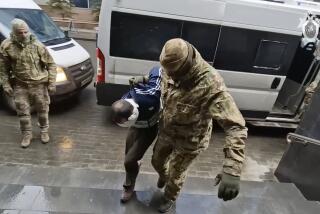Regional Outlook : Warriors and Refugees Rattle Border Guards in Central Asia : Afghan arms smugglers and people fleeing turmoil in Tajikistan overwhelm a remote post--a symbol of spreading conflicts.
- Share via
PYANDZH, Tajikistan — What could they do? Their military duty required them to defend the border and open fire on anyone who violated it. But these were women and children and old people, fleeing across the Pyandzh River to escape the bloodshed afflicting their homeland in Tajikistan.
“We were caught in a very complex position,” said Lt. Col. Vladimir Zhernakov, deputy commander of the Russian guards who man the border with Afghanistan here. “It was happening before our very eyes, but you can’t fire when it’s women and children.”
And so, what was once a tightly controlled boundry between the Soviet Union and Afghanistan turned in late December into a partly open gateway, allowing tens of thousands of refugees and retreating militants through. The crowds simply broke down the elaborate system of fencing and alarms at the frontier, and the guards were powerless to stop them.
In recent days, the mass crossings into Afghanistan have stopped, but an estimated 80,000 refugees in the border region linger, and Russian guards continue to face frequent clashes with Afghan fighters slipping across to sell arms or their own services.
The Pyandzh River is becoming a powerful symbol of a problem threatening not only this remote former Soviet republic, but much of a fast-changing Central Asia: a mixture of clan and ideological warfare that can spread at any time across the new national borders of the region.
Eight months of civil war among Tajikistan’s 5 million people have left at least 20,000 people believed dead and hundreds of thousands of refugees on the road.
The turmoil has neighboring Central Asian states doubly worried. The Tajik conflict appears to be bringing mass, Afghanistan-style violence into former Soviet territory. And it could be a frightening harbinger of what awaits them all.
“In the geopolitical sense, Tajikistan was the most vulnerable point of the former Soviet Union,” presidential adviser Rustam Mirzoyev said. “It’s a small republic that has an enormous border with an unstable country--Afghanistan.
“Iranian extremism came to us through Afghanistan,” Mirzoyev said, referring to the Islamic fundamentalist opposition that Tajikistan’s current pro-Communist government now appears to have vanquished.
Many see the arbitrary internal borders of the former Soviet Union as another cause of the Tajik conflict. The boundaries created by the Bolsheviks on the maps of the early 1920s were often carelessly drawn and left entities like Tajikistan with weak internal fault lines likely to give way under tension.
Much of the recent fighting is simple clan warfare among traditional rivals or enemies in regions that Soviet authorities somewhat arbitrarily lumped together into Tajikistan.
In this too Tajikistan mirrors Afghanistan--a patchwork country where Tajiks, Pushtuns and Uzbeks are slugging it out for control. If Afghanistan’s ethnic Tajiks lose control of Kabul, the capital, some analysts foresee an attempt to set up a Tajik state in northern Afghanistan at the risk of further destabilizing the region by attempting to do away with the old Soviet border altogether and uniting Tajiks from both sides.
The hundreds of thousands of Afghan Tajiks have natural ties with their once-Soviet brethren across the 600-mile border, and ex-Soviet Tajiks also communicate easily with the Pushtun, whose language, like Tajik, is Persian-based.
In a way, said Habib Rabiyev, head of the Tajik government’s committee on religion, today’s mishmash really began “when England and Russia divided Central Asia on the River Pyandzh” in 1885.
For years, tough Soviet border controls kept the two sides of the Pyandzh well separated. But recent months have found Russian guards--leftovers from the Soviet era with a mission to keep turmoil at arm’s length from home--overwhelmed by the pressure from both sides of the international boundary. It does not help that their border base has suffered cutoffs of cooking gas, breakdowns of electricity and bread shortages.
A unit of young Russian marines, pure joy on their faces as they waited to board a helicopter on their way home after four months of service on the border near Pyandzh, told harrowing tales of the frequent firefights near their isolated outposts.
“There were four of us marines, and we ran into six dushmani, “ Sgt. Alexander Semenyutin recalled, referring to Afghan resistance fighters. “They opened fire on us, we fired at them, then they started to chase us, then we turned it around and started to chase them,” finally losing them in the high reeds of the Pyandzh River.
Valery Romantsov, a blond sergeant with aquamarine eyes, displayed the medal he won when his group of six men managed to capture 11 Afghan arms smugglers just as they were trying to install a large underground pipe to let them slither under the border’s alarm system.
“We weren’t even armed but we took them anyway,” he said, his chest puffing. “We’re marines.”
Tajikistan’s National Security Ministry shows videotapes of Afghan arms smugglers and fighters caught at the border, mountain men with dense black beards and one long line of thick black eyebrow across their foreheads.
Deputy Security Minister Inkhom Rakhmatov said that Afghan allies of the Islamic opposition “do propaganda work and call their men to cross the border and declare a jihad (holy war) against the Communists who are fighting their Islamic brethren.”
According to the Tajik government, Tajiks willing to trade cars for arms have driven more than 6,000 vehicles over the border into Afghanistan. Zhernakov, the deputy Russian guard commander, said his men have caught Tajik smugglers leaving with everything from jewels to peacocks.
Neither Tajik officials nor the Russian guards blame the Afghan government for the border problems, noting that the north of Afghanistan is run by Afghan opposition groups and is out of Kabul’s control.
But the disorder in Afghanistan does mean that the border troops have “no one to talk to” to arrange better joint defense of the frontier, Zhernakov said.
The Russian troops complain that they are seen as interlopers by both the Tajiks and the Afghans, but Zhernakov said they have no doubts about what they are doing here. They are the forward defense for Russia, he said, blocking arms and fighters that could otherwise stream unhindered from Afghanistan right on to the Slavic motherland.
“With the border open, anyone can send a rocket flying right from here to Russia,” warned Imomali Rakhmonov, Tajikistan’s new leader.
The other states of what was Soviet Central Asia--Turkmenistan, Kyrgyzstan and Uzbekistan, plus Kazakhstan to the north--have few soldiers to spare for someone else’s border. But they have repeatedly discussed the need for peacekeepers in Tajikistan and admitted their fear that “the Tajik variant” would overtake them as well.
President Islam Karimov of Uzbekistan has been loudest in his warnings, and rightly so, Tajik officials said.
“The Tajik conflict can easily spread to the entire Central Asian region,” said Tahir Akhmedov, deputy consular chief in the Tajik Foreign Ministry. “There are over 1 million Uzbeks in Tajikistan, and millions of Tajiks in Uzbekistan. This process can easily leak.”
It appears that it already has.
Last week, Kyrgyz media reported that three Kyrgyz people had been killed and 18 taken hostage by Tajik militants. News media in Bishkek, the Kyrgyz capital, also reported that Tajiks had tried to waylay humanitarian aid meant for the Kyrgyz regional center of Osh.
Tajik officials claim that Islamic fundamentalists similar to those in Tajikistan were the real force behind ethnic warfare in the Fergana Valley of Uzbekistan in the summer of 1989 that left more than 100 dead.
And members of the Tajik opposition say that thousands of Uzbek troops have been fighting on behalf of the Tajik government, doing some of its bloodiest work. The Tajik government acknowledges only that Uzbekistan has sent reinforcements to man the Afghan border, but it says the Uzbek help is not enough.
Pointing out that the Afghan border is of general concern, Tajik leaders have said they may appeal to the Commonwealth of Independent States--the loose grouping of 11 former republics formed in the wake of the Soviet Union’s 1991 collapse--for more troops. But with the Commonwealth foundering and Russia in no hurry to send more soldiers, Tajikistan may end up depending only on its closest neighbors for help.
The leaders of Uzbekistan, Kazakhstan, Tajikistan, Turkmenistan and Kyrgyzstan met Jan. 4 in the Uzbek capital of Tashkent, discussed possible joint defense arrangements and hinted they might form their own commonwealth. This prompted predictions of a resurrected Turkestan--the historic region that once spanned Central Asia.
The Central Asian idea of joining forces holds the promise not only of quieting down Tajikistan but also alleviating other regional tensions that stemmed from the arbitrary border-drawing under the Bolsheviks, the Russian newspaper Nezavisimaya Gazeta commented.
“A united Turkestan, in the opinion of the Central Asian leaders who respect strong power, could become a panacea for the region’s ills,” it said.
More to Read
Sign up for Essential California
The most important California stories and recommendations in your inbox every morning.
You may occasionally receive promotional content from the Los Angeles Times.













